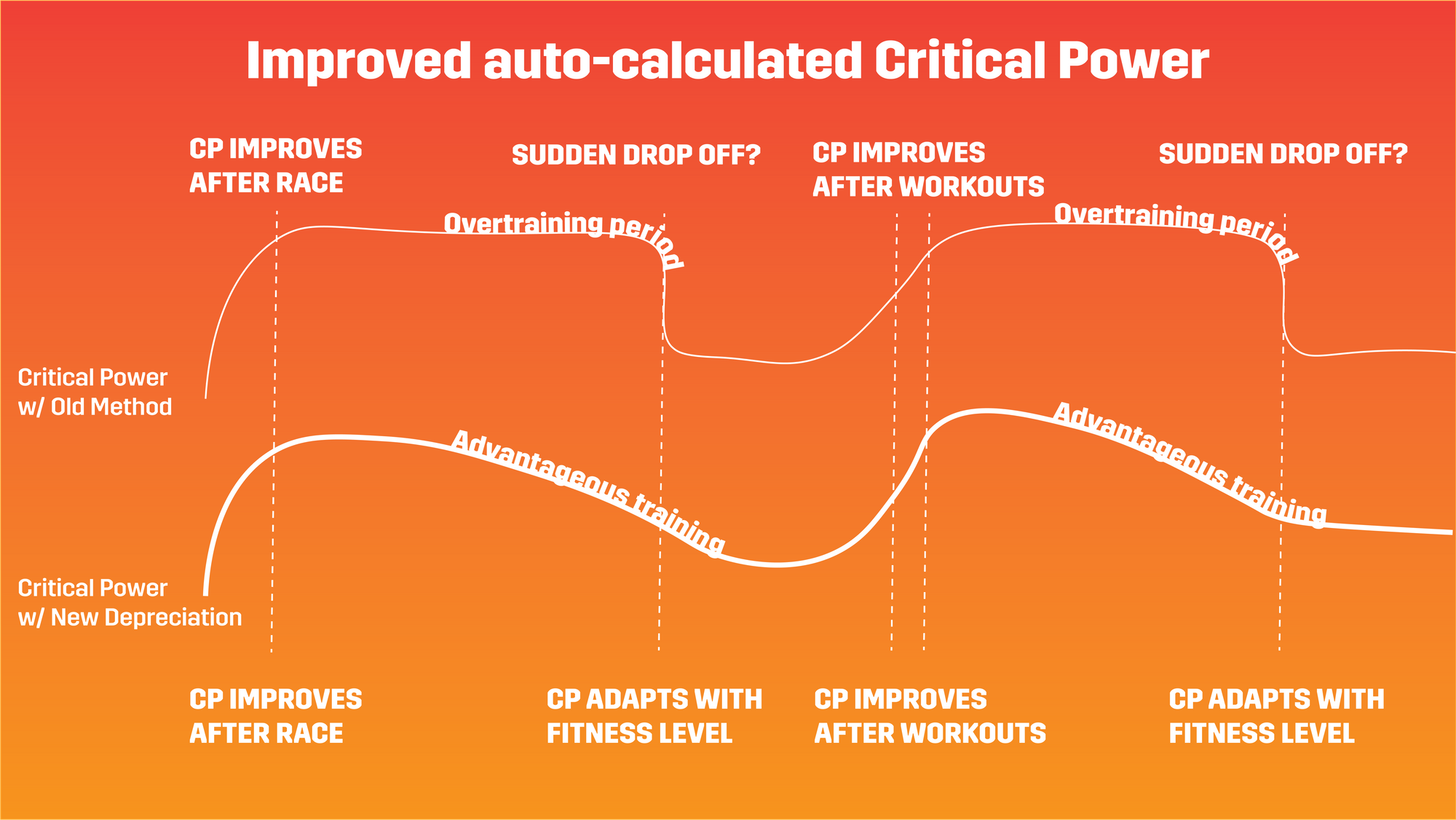‘Depreciation’ in auto-calculated Critical Power encourages you to keep developing your fitness

Today, we introduce a ‘depreciation’ factor into how we determine your auto-calculated Critical Power. This update means that Critical Power is more attuned and responsive to your current fitness because it now correctly considers that a workout from the past has less of a contribution to your fitness than a recent workout does.
This new ‘depreciation’ feature is beneficial for you because it:
- Encourages you to continue logging high quality run sessions so your fitness continually improves
- Recommends more realistic training zones if you are returning from injury or a break
What is ‘depreciation’?
Depreciation means that older workouts will not contribute the same as new workouts when we auto-calculate your Critical Power. Essentially, the value that a previous activity has to your current fitness level depreciates over time. This method of accounting for beneficial workouts is more reflective of how the body works because you will maintain fewer positive adaptations from a month-old workout compared to a day-old workout.
How does ‘depreciation’ work in auto-calculated Critical Power?
Before we begin, it is important to remember the purpose of auto-calculated Critical Power. Auto-calculated Critical Power is built to give you a responsive and accurate read on your current fitness. From an accurate Critical Power, we can tell you a set of power training zones that will maximize optimal training.
Previously, our auto-calculated Critical Power tool looked at your previous three months of running and evaluated how each of those runs contributed to your fitness. A run from a month ago would be considered just as beneficial as a run from a day ago. This method works well if you are training consistently. However, this method can fall short if your training experiences large variations. Here are a few examples of large variations in normal run training:
Example #1: You raced three months ago and now that race has fallen outside of the auto-calculated Critical Power window. In this situation, your Critical Power has suddenly dropped, however your true fitness has not.
Example #2: You have been taking a break for a few weeks after an injury. In this situation, your Critical Power will remain high because your training in the last few months is still being considered, but your true fitness has degraded from your time off.
In both of these common situations, your auto-calculated Critical Power will be temporarily wrong and you will be forced to either over or under exert in your training. Neither scenario is optimal.
How do we solve this problem?
Today, we introduce a “depreciation” factor in the auto-calculated Critical Power tool. We still use your previous three months of data to determine your Critical Power, but the value of older runs will depreciate over time to your Critical Power.
Specifically, here is how it works:
- Your most recent month of training will fully contribute to Critical Power.
- Activities older than a month will have a “depreciation factor” applied to them and these runs will continue to depreciate until they fall outside of the three month consideration window.
By applying a depreciation factor, auto-calculated Critical Power is still accurate even when there are large variations (due to racing or resting) in your training.

How do you benefit from ‘depreciation’?
Your Critical Power is more up-to-date.
- Stryders are more likely to balance their training because they are less likely to rely on old training to prop up their Critical Power. This is superior to the previous system because you will not be forced into workouts or race recommendations that are too intense for your current fitness.
Your Critical Power is more responsive.
- Stryders will see less unexpected or unexplainable drops in their Critical Power because runs will no longer suddenly fall outside of the consideration window.
- It is easier to feel and see accomplishment/progress for positively contributing workouts.
How can you activate this new feature?
This feature is already active on your Stryd account. After you upload your next run, your auto-calculated Critical Power will update according to the new ‘depreciation’-based rules we have added to the system.
FAQ
How frequently can users expect Critical Power to depreciate?
- You can expect your Critical Power to update and change more frequently because old ‘depreciating’ runs will give you the opportunity to log more positively contributing runs.
How much will Critical Power depreciate?
- The amount that Critical Power depreciates depends on how old your positively contributing workouts are. If you are training consistently, you are unlikely to see your Critical Power drop much because your more recent runs will always take precedence. If you have not raced in awhile or if you took a break, you will see Critical Power depreciate because you have likely not logged any positively-contributing runs that rival your past efforts.
When will Critical Power stop depreciating?
- Critical Power will stop depreciating when you begin to log positively contributing runs again.
Will I be notified every time that Critical Power depreciates? Or, how does the notification system change?
- Your Critical Power updates when you complete a run and you will only be notified when Critical Power increases.
How should I adjust my training with this new system?
- You should pay attention to changes in your power zones because these changing zones will help improve your daily training efforts because Critical Power is more accurate and responsive to your current fitness.
How do weight changes factor into this new feature?
- This feature will not have an effect on your experience much if you choose to frequently update your Stryd weight setting or if you do not.
Should I be concerned if my Critical Power is constantly dropping?
- If you are training consistently but you are seeing a continually and consistently dropping Critical Power, you should pay attention to the intensity of the training. E.g., running easy every day has a different effect on your fitness from running structured workout with intensities variety. The latter is likely better for your fitness.

If you are a current Stryder, please ensure that you have enabled auto-calculated Critical Power. Then, you must only log a new run to update your Critical Power.
If you are not yet a Stryder, please click here if you would like to learn about and purchase the new Stryd.
Best,
The Stryd Team
